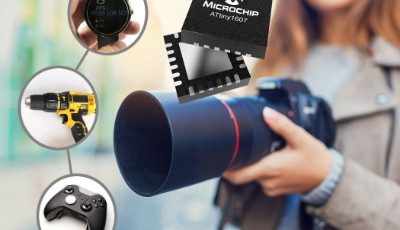New Microchip PIC® and AVR® MCUs increase system performance in closed-loop control applications
May 21, 2018
on
on

Microchip announces the introduction of new PIC18 Q10 and ATtiny1607 families of 8-bit microcontrollers (MCUs), featuring multiple intelligent Core Independent Peripherals (CIPs) that simplify development and enable a quick response time to system events.
Advancements in the architecture of PIC® and AVR® MCUs have optimised these devices for implementing closed-loop control, enabling systems to offload the Central Processing Unit (CPU) to manage more tasks and save power.
A key advantage of the PIC18 Q10 and ATtiny1607 MCUs are the CIPs that independently manage tasks and reduce the amount of processing required from the CPU. System designers can also save time and simplify design efforts with the hardware-based CIPs, which significantly reduce the amount of software that needs to be written and validated. Both families have features for functional safety and operate up to 5V, increasing noise immunity and providing compatibility with the majority of analogue output and digital sensors.
Offered in a compact 3 x 3 mm 20-pin QFN package, the new ATtiny1607 family is optimised for space-constrained closed-loop control systems such as hand-held power tools and remote controls. In addition to the integrated high-speed Analogue-to-Digital Converter (ADC) that provides faster conversion of analogue signals resulting in deterministic system response, the devices provide improved oscillator accuracy, allowing designers to reduce external components and save costs.
Among the CIPs in the PIC18 Q10 family are the Complementary Waveform Generator (CWG), which simplifies complex switching designs, and an integrated Analogue-to-Digital Converter with Computation (ADC2) that performs advanced calculations and filtering of data in hardware without any intervention from the core. CIPs such as these allow the CPU to execute more complex tasks, such as Human Machine Interface (HMI) controls, and remain in a low-power mode to conserve power until processing is required.
Advancements in the architecture of PIC® and AVR® MCUs have optimised these devices for implementing closed-loop control, enabling systems to offload the Central Processing Unit (CPU) to manage more tasks and save power.
A key advantage of the PIC18 Q10 and ATtiny1607 MCUs are the CIPs that independently manage tasks and reduce the amount of processing required from the CPU. System designers can also save time and simplify design efforts with the hardware-based CIPs, which significantly reduce the amount of software that needs to be written and validated. Both families have features for functional safety and operate up to 5V, increasing noise immunity and providing compatibility with the majority of analogue output and digital sensors.
Offered in a compact 3 x 3 mm 20-pin QFN package, the new ATtiny1607 family is optimised for space-constrained closed-loop control systems such as hand-held power tools and remote controls. In addition to the integrated high-speed Analogue-to-Digital Converter (ADC) that provides faster conversion of analogue signals resulting in deterministic system response, the devices provide improved oscillator accuracy, allowing designers to reduce external components and save costs.
Among the CIPs in the PIC18 Q10 family are the Complementary Waveform Generator (CWG), which simplifies complex switching designs, and an integrated Analogue-to-Digital Converter with Computation (ADC2) that performs advanced calculations and filtering of data in hardware without any intervention from the core. CIPs such as these allow the CPU to execute more complex tasks, such as Human Machine Interface (HMI) controls, and remain in a low-power mode to conserve power until processing is required.
Read full article
Hide full article


Discussion (0 comments)